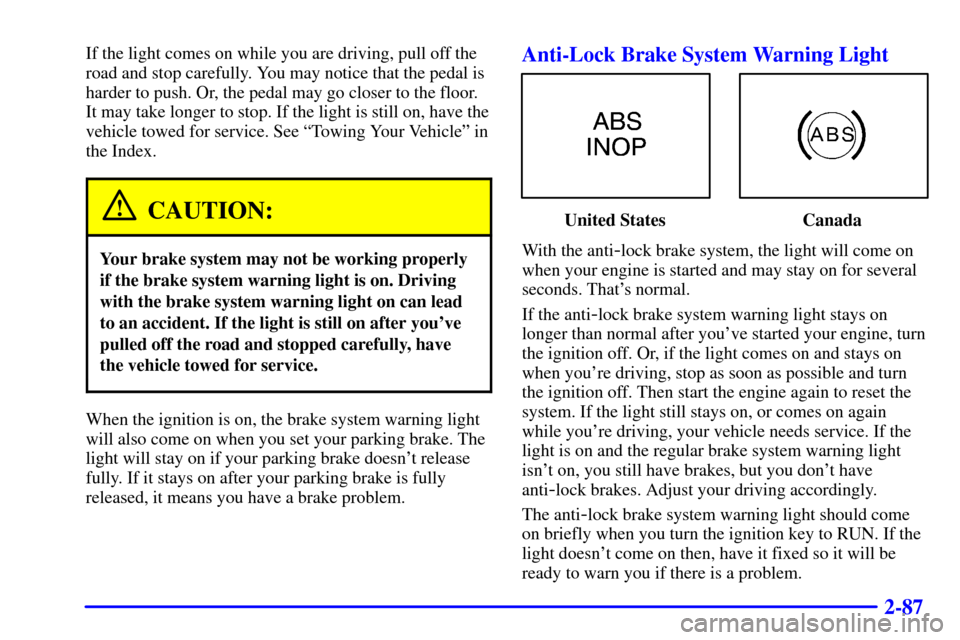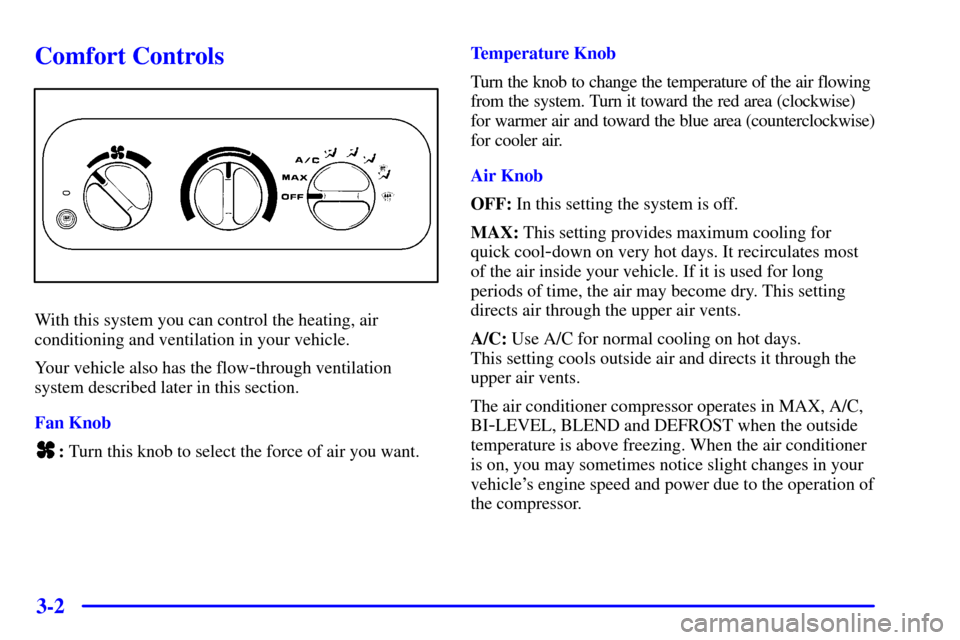Page 109 of 363

2-51 Turn Signal and Lane Change Indicator
The turn signal has two upward (for right) and two
downward (for left) positions. These positions allow you
to signal a turn or a lane change.
To signal a turn, move the lever all the way up or down.
When the turn is finished, the lever will return automatically.
An arrow on the instrument
panel cluster will flash in
the direction of the turn or
lane change.
To signal a lane change, just raise or lower the lever
until the arrow starts to flash. Hold it there until you
complete your lane change. The lever will return by
itself when you release it.As you signal a turn or a lane change, if the arrows don't
flash but just stay on as you signal a turn or lane change,
a signal bulb may be burned out and other drivers won't
see your turn signal.
If a bulb is burned out, replace it to help avoid an
accident. If the arrows don't go on at all when you
signal a turn, check the fuse (see ªFuses and Circuit
Breakersº in the Index).
Headlamp High/Low-Beam Changer
When the high beams are
on, this light located on the
instrument panel cluster
also will be on.
To change the headlamps from low beam to high or high
beam to low, pull the turn signal lever all the way
toward you. Then release it.
Page 120 of 363
2-62
Removing the Cargo Cover
1. Close the cover. If the cargo cover is not closed and
resting on the trim panel, it cannot be removed.
2. Pull the cover toward you to unsnap it. Then slide
the cargo cover along the groove in the trim panel.
Reverse the steps to install the cover.
CAUTION:
An improperly stored cargo cover could be
thrown about the vehicle during a collision or
sudden maneuver. You or others could be
injured. If you remove the cover, always store it
outside your vehicle. When you put it back,
always be sure that it is securely reattached.
Page 124 of 363
2-66
2. Then pull on the release handle to unlatch the panel.
3. Lift the outer edge of the panel and pull it toward
you. Then carry the panel to the rear of the vehicle
for storage.
Storing the T-Top Roof Panels
CAUTION:
If the T-top panel is not stored properly, it could
be thrown about the vehicle in a crash or sudden
maneuver. People in the vehicle could be injured.
Whenever you store the T
-top panel in the
vehicle, always be sure that it is stored securely in
the proper storage slot at the rear of the vehicle.
1. Open the cargo cover completely.
Page 127 of 363
2-69
2. After the inboard edge of the panel is in position under
the center roof rail, lower the outboard edge of the panel
into position, close the latch and lock the T
-top.NOTICE:
Do not attempt to install the panels by sliding
them horizontally toward the center roof rail.
Doing so may cause the weatherstrips to be
aligned improperly, which may result in leaks
and possible damage to the weatherstrips.
NOTICE:
High pressure car washes may cause water to
enter your vehicle. Never spray water directly at
the roof panel joints. This will cause leaks.
Page 145 of 363

2-87
If the light comes on while you are driving, pull off the
road and stop carefully. You may notice that the pedal is
harder to push. Or, the pedal may go closer to the floor.
It may take longer to stop. If the light is still on, have the
vehicle towed for service. See ªTowing Your Vehicleº in
the Index.
CAUTION:
Your brake system may not be working properly
if the brake system warning light is on. Driving
with the brake system warning light on can lead
to an accident. If the light is still on after you've
pulled off the road and stopped carefully, have
the vehicle towed for service.
When the ignition is on, the brake system warning light
will also come on when you set your parking brake. The
light will stay on if your parking brake doesn't release
fully. If it stays on after your parking brake is fully
released, it means you have a brake problem.
Anti-Lock Brake System Warning Light
United States Canada
With the anti
-lock brake system, the light will come on
when your engine is started and may stay on for several
seconds. That's normal.
If the anti
-lock brake system warning light stays on
longer than normal after you've started your engine, turn
the ignition off. Or, if the light comes on and stays on
when you're driving, stop as soon as possible and turn
the ignition off. Then start the engine again to reset the
system. If the light still stays on, or comes on again
while you're driving, your vehicle needs service. If the
light is on and the regular brake system warning light
isn't on, you still have brakes, but you don't have
anti
-lock brakes. Adjust your driving accordingly.
The anti
-lock brake system warning light should come
on briefly when you turn the ignition key to RUN. If the
light doesn't come on then, have it fixed so it will be
ready to warn you if there is a problem.
Page 148 of 363

2-90
NOTICE:
If you keep driving your vehicle with this light
on, after a while, your emission controls may not
work as well, your fuel economy may not be as
good and your engine may not run as smoothly.
This could lead to costly repairs that may not be
covered by your warranty.
NOTICE:
Modifications made to the engine, transmission,
exhaust, intake or fuel system of your vehicle or
the replacement of the original tires with other
than those of the same Tire Performance Criteria
(TPC) can affect your vehicle's emission controls
and may cause the SERVICE ENGINE SOON or
CHECK ENGINE light to come on.
Modifications to these systems could lead to
costly repairs not covered by your warranty. This
may also result in a failure to pass a required
Emission Inspection/Maintenance test.
This light should come on, as a check to show you it is
working, when the ignition is on and the engine is not
running. If the light doesn't come on, have it repaired.
This light will also come on during a malfunction in one
of two ways:
�Light Flashing
-- A misfire condition has been
detected. A misfire increases vehicle emissions and
may damage the emission control system on your
vehicle. Dealer or qualified service center diagnosis
and service may be required.
�Light On Steady
-- An emission control system
malfunction has been detected on your vehicle.
Dealer or qualified service center diagnosis and
service may be required.
If the Light Is Flashing
The following may prevent more serious damage to
your vehicle:
�Reducing vehicle speed.
�Avoiding hard accelerations.
�Avoiding steep uphill grades.
�If you are towing a trailer, reduce the amount of
cargo being hauled as soon as it is possible.
Page 156 of 363

3-2
Comfort Controls
With this system you can control the heating, air
conditioning and ventilation in your vehicle.
Your vehicle also has the flow
-through ventilation
system described later in this section.
Fan Knob
: Turn this knob to select the force of air you want.Temperature Knob
Turn the knob to change the temperature of the air flowing
from the system. Turn it toward the red area (clockwise)
for warmer air and toward the blue area (counterclockwise)
for cooler air.
Air Knob
OFF: In this setting the system is off.
MAX: This setting provides maximum cooling for
quick cool
-down on very hot days. It recirculates most
of the air inside your vehicle. If it is used for long
periods of time, the air may become dry. This setting
directs air through the upper air vents.
A/C: Use A/C for normal cooling on hot days.
This setting cools outside air and directs it through the
upper air vents.
The air conditioner compressor operates in MAX, A/C,
BI
-LEVEL, BLEND and DEFROST when the outside
temperature is above freezing. When the air conditioner
is on, you may sometimes notice slight changes in your
vehicle's engine speed and power due to the operation of
the compressor.
Page 157 of 363

3-3
BI-LEVEL: This setting directs air through the
upper air vents and the heater ducts.
VENT: This setting directs air through the upper
air vents.
HEATER: This setting directs most of the air
through the heater ducts and some of the air through the
windshield defroster vents.
BLEND: This setting directs air through the
windshield defroster vents and the heater ducts.
DEFROST: This setting directs most of the air
through the windshield defroster vents and some of the
air through the heater ducts.
Cooling
The air conditioner works best if you keep your
windows closed. On very hot days, open the windows
just long enough for the hot air to escape.
1. Turn the air knob to A/C for normal cooling. For
faster cooling turn the knob to MAX.
2. Turn the temperature knob to a
comfortable setting.
3. Turn the fan knob to the desired speed.
Heating
The heater works best if you keep your windows closed
while using it.
1. Turn the air knob to HEATER.
2. Turn the fan knob to the desired speed.
3. Turn the temperature knob to a
comfortable setting.
If your vehicle is equipped with an engine coolant heater,
you can use it in cold weather (around 20�F/
-8�C or
lower) to improve heater performance on initial start up.
See ªEngine Coolant Heaterº in the Index.
Bi
-Level
You may want to use BI
-LEVEL on cool, but sunny
days. This setting directs cool air toward your body and
warmer air toward your feet.
1. Turn the air knob to BI
-LEVEL.
2. Turn the temperature knob to a
comfortable setting.
3. Turn the fan knob to the desired speed.